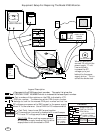
SAFETY FIRST; Use only one hand when working on a powered up monitor to avoid electrical shock.
POWER SUPPLY, TROUBLE SHOOTING TIPS.
If the V+ crowbar zener 181 is shorted, a fault
exists in the power supply which permitted the V+
line to exceed +160V. First replace the zener.
Never operate the monitor without the crowbar
zener installed. Then read the
POWER SUPPLY
TEST section on this page. Shorts on the V+, 24V,
and 16V lines other than the crowbar zener are not
likely to be connected to the power supply even
though the power supply chirps. By operating the
power supply with the +20V external power supply
many of these problems can be found using the
same procedure as are used in trouble shooting
monitors with linear power supplies.
For the overloaded supply line problems, the
monitor power supply can be made to run
continuously by connecting the external power
supply to the 17V line. To accomplish this,
connect the external supply 0V clip lead to V-
(resistor
137 lead by the power transformer) and
+20V clip lead to the monitor power supply +17V
line (cathode of diode
141 ). Sometimes the
monitor will operate normally in this mode, in
which case, watch for smoke and after a few
minutes of operation disconnect the power
connections and carefully feel around the
conductor side of the board for hot spots. Overload
conditions will not harm the power supply unless
there is a problem in the power supply. If the
power supply is suspect, read the
POWER SUPPLY
TEST section on this page. Next check the DC
voltage of each of the power supply outputs. The
overloaded line will have a lower than normal
voltage reading. The defective component can be
located by measuring the voltage drop along the
trace of this line.
A quick check for the insufficient V+ load is to
connect a 2K to 4K ohm 10 watt power resistor
from GND to the V+ (cathode of diode 181 ). If the
chirping stops, proceed to check the horizontal
deflection circuit. First disconnect the board from
the AC supply. Then connect 16 volts to the 16V
line at the cathode of 169 . Also connect 24 volts
to the 24V line at the cathode of diode 168 and to
V+ at the cathode of diode 181 on the monitor.
Now the complete horizontal and vertical circuits
can be checked with the oscilloscope and DVM.
The flyback waveform will be about 170Vp-p
instead of 900Vp-p which permits checking even
the H. output transistor, collector, waveform.
Many of the failures that cause burnt
components and boards are eliminated by the
load sensitive switching mode power supply in
the CERONIX monitor. This feature can cause
problems with servicing the monitor if the proper
trouble shooting approach is not used. The
equipment setup, shown here, is necessary for
efficient trouble shooting of the CERONIX
monitors.
Always wear safety glasses.
1.
2.
3.
The power supply may chirp if:
The +17V line is open. (goes away
when external. PS is used)
The .33 ohm current sensing
resistor value is too high.
The transformer core is broken or a
winding is shorted.
4.
There is a line voltage range of about 60% to
70% AC line voltage where a correctly
operating monitor will chirp.
5.
1. Insufficient V+ line load.
2. Overloaded V+, +24V, or +16V lines.
3. Shorted V+, +24V, or +16V lines.
4. Power supply component failure.
5. Raw DC (V+ to V-) voltage too low.
Problems that cause the power supply to chirp are:
To verify that the power supply is working
correctly, connect the 17V line, as indicated in
section 2 on this page. Also connect the
oscilloscope GND to V- and the oscilloscope probe to
the FET drive (anode of diode 116 ). There should
be a waveform at this point. If there is no FET
drive waveform, check the voltages and waveforms
on the C5184 pins and compare them to the
voltages and waveforms on the schematic.
Connect the AC power cord with the AC voltage,
from the variable transformer turned down to 0
volts. TAKE CARE NOT TO TOUCH THE
OSCILLOSCOPE AND MONITOR CHASSIS
DURING THIS TEST, SINCE THE VOLTAGE
DIFFERENCE CAN BE AS HIGH AS 400 VOLTS.
Connect the DVM to GND and V+. Slowly
increase the AC line voltage and observe the power
supply response. Do not exceed +145V on V+. If
the monitor runs normally, a fault may still exist
in the power supply +17V line circuit. Note; if
the crowbar zener is shorted and the FET is
internally shorted, the C5184 IC 115 should also
be replaced.
POWER SUPPLY TEST
137
181
168
169
141
181
115
116
181
94


















